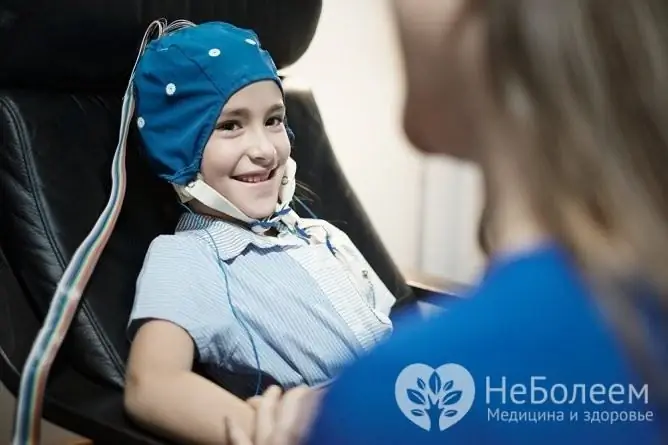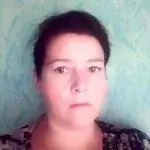- Author Rachel Wainwright [email protected].
- Public 2023-12-15 07:39.
- Last modified 2025-11-02 20:14.
Epilepsy in children
The content of the article:
- The reasons
- Classification
-
Symptoms of epilepsy in children
- Big seizure
- Small seizure
- Simple focal seizures
- Complications
- Diagnostics
- Treatment of epilepsy in children
- First aid
- How to suspect epilepsy
- Forecast
- Video
Epilepsy in children is a chronic neurological disorder that manifests itself in recurrent seizures or their equivalents (sensory, mental, autonomic). The occurrence of epileptic seizures is associated with a violation of the synchronous electrical activity of the nerve cells in the brain.
According to medical statistics, 2-5% of children suffer from epilepsy. In 70-75% of adult patients suffering from this disease, its first signs appeared before the age of 16 years.

Epilepsy is one of the most common neurological diseases that occur in childhood
In children and adolescents, there are both benign and malignant (therapy-resistant, progressive) forms of the disease. Often, epileptic seizures in children proceed with an erased clinical picture or atypically, and changes in the electroencephalogram (EEG) do not always correspond to the symptoms.
Epileptologists - neurologists with special training are engaged in the study of the problem of childhood epilepsy.
The reasons
The main factor underlying the pathological mechanism of the onset of the disease at an early age is the immaturity of the brain structures, which is characterized by the predominance of excitability over inhibition. This leads to a violation of the formation of the correct connections between individual neurons.
An increased convulsive readiness can also be provoked by various premorbid brain lesions of a hereditary or acquired nature.
It is known that if one of the parents suffers from the disease, the child has a 10% risk of developing it.
Also, the development of childhood epilepsy can lead to:
- chromosomal abnormalities (Down syndrome, Marfan syndrome);
- hereditary metabolic disorders (hyperglycinemia, leucinosis, phenylketonuria, mitochondrial encephalomyopathies);
- hereditary neurocutaneous syndromes (tuberous sclerosis, neurofibromatosis).
In the structure of the incidence of children, a fairly large part falls on the forms associated with prenatal and postnatal brain damage. Prenatal risk factors for developing the disease include:
- severe toxicosis of pregnancy;
- intrauterine infections;
- fetal hypoxia;
- severe jaundice of newborns;
- intracranial birth trauma;
- fetal alcohol syndrome.
The first manifestations of the disease caused by prenatal factors usually occur in babies at the age of 1-2 years.
In children aged 3-6 years and older, the manifestations of pathology are usually caused by:
- complications of infectious diseases (pneumonia, flu, sepsis);
- transferred neuroinfectious diseases (arachnoiditis, encephalitis, meningitis);
- congenital pathologies of the brain.
In patients with infantile cerebral palsy (ICP), epilepsy is diagnosed in 25-35% of cases.
Classification
Depending on the characteristics of epileptic seizures, several forms of the disease are distinguished:
| Disease form | Attack characteristics |
| Focal |
The disease proceeds with focal (partial, local) seizures, which can be: · Simple (with mental, somatosensory, autonomic and motor components); • complex - they are characterized by impaired consciousness; · With secondary generalized attacks of tonic-clonic seizures. |
| Generalized |
The disease is characterized by recurrent primary generalized seizures: · Tonic-clonic seizures; · Clonic seizures; · Abanses (atypical, typical); · Atonic seizures; · Myoclonic seizures. |
| Unclassified |
It proceeds with unclassified seizures: · Reflex; · Random; · Repeated; · Status epilepticus. |
Depending on the etiological factor, generalized and localized forms of epilepsy are divided into several types:
- cryptogenic;
- symptomatic;
- idiopathic.
Among idiopathic generalized forms of the disease, benign convulsions of newborns, abanse and myoclonic epilepsy in children and adolescents are most often observed. The structure of the incidence of focal forms is dominated by:
- epilepsy reading;
- epilepsy with occipital paroxysms;
- Rolandic benign epilepsy.
Symptoms of epilepsy in children
The clinical signs of epilepsy in children are quite diverse and are determined by the type of seizures, the form of the disease.
An epileptic seizure is usually preceded by the appearance of precursors, which can be attributed to:
- affective disorders (fear, headache, irritability);
- aura (mental, olfactory, gustatory, visual, auditory, somatosensory).
Big seizure
In a generalized (large) seizure, the patient suddenly loses consciousness, lets out a loud groan and falls. Immediately after this, the stage of tonic convulsions begins. Clinically, it manifests itself:
- muscle tension;
- clenching of the jaws;
- throwing back the head;
- dilated pupils;
- apnea;
- cyanosis of the face;
- stretching the legs;
- flexion of the arms at the elbow joints.
Tonic convulsions last a few seconds and are replaced by clonic convulsions, which last 1-2 minutes. This seizure period is characterized by the following symptoms:
- involuntary urination and defecation;
- biting the tongue;
- discharging foam from the mouth;
- noisy breathing.
After the end of the attack, the patient usually does not respond to external stimuli and falls asleep. After the recovery of consciousness, the patients do not remember about the seizure.
Small seizure
Absences or minor seizures are characterized by short-term loss of consciousness (up to 20 seconds). At the same time, the patient's eyes freeze, speech, movement stops. After the end of the attack, he continues his occupation, as if nothing had happened.
With complex absences, various phenomena are noted:
- motor (contractions of facial muscles, rolling of the eyeballs, myoclonic twitching);
- vasomotor (sweating, salivation, blanching or redness of the face);
- motor automatisms.
Absenteeism attacks occur repeatedly during the day and almost daily.
Simple focal seizures
In children, this form of the disease may be accompanied by:
- unusual sensations (somatosensory, gustatory, visual, auditory);
- twitching of certain muscle groups;
- mental disorders;
- an increase in body temperature;
- sweating;
- tachycardia;
- nausea;
- abdominal or headache.
Complications
The consequences of a long course of epilepsy can be:
- behavior disorders;
- learning difficulties;
- attention deficit disorder;
- hyperactivity syndrome;
- decreased intelligence.
Diagnostics
Diagnosis of the disease is based on the study by an epileptologist of anamnesis data, neurological examination, laboratory and instrumental research methods. To make a diagnosis, the doctor needs to get answers to the following questions:
- what is the time of onset, duration and frequency of attacks;
- what are the features of the course of the attack;
- there is or is not an aura, if any, what are its features.
Parents should tell the epileptologist in great detail about the nature of their child's seizures. If possible, it is advisable to film the attack and show this recording to a specialist. Considering that young children, for example, at the age of 3, cannot always tell the doctor about their condition, such a video is very helpful in the early diagnosis of the disease.
If epilepsy is suspected, the baby is sent for electroencephalography (EEG). If necessary, the doctor may recommend EEG monitoring (daily, night).
Ancillary diagnostic methods include:
- X-ray of the skull;
- PET, MRI or CT of the brain;
- ECG and daily ECG monitoring.

Thorough diagnostics will help you choose the best treatment option
Treatment of epilepsy in children
Children with epilepsy are prescribed long-term, often lifelong therapy with anticonvulsants (anticonvulsants). With a resistant form of the disease, alternative methods of therapy can be used:
- immunotherapy;
- ketogenic diet;
- hormone therapy.
The complex treatment regimen includes biofeedback therapy, psychotherapy.
If indicated, surgical treatment is possible. The following operational techniques are most often used:
- stimulation of the vagus nerve with an implantable device;
- limited temporal resection;
- extratemporal neocortical resection;
- anterior temporal lobectomy;
- hemispherectomy.
First aid
Parents of children with epilepsy should know how to give them first aid at the time of the seizure. When the precursors appear, the child must be laid on his back, the collar must be unbuttoned and the flow of fresh air must be provided.
To prevent aspiration of saliva or vomit, as well as retraction of the tongue, the head is turned to the side.
How to suspect epilepsy
Childhood epilepsy often begins with non-convulsive seizures and is therefore difficult to recognize. Parents should closely monitor the development of their children. The latent period of the disease may be indicated by the following features in the behavior of the child:
- walking in a dream;
- pronouncing the same type of sounds or words in a dream;
- systematic nightmares.
In one-year-old children, the first sign of the disease is rapid head tilting forward (nodding symptom).
Forecast
Modern pharmacotherapy can achieve control over the disease in most children. With a normal EEG picture and no seizures, after 3-4 years, a gradual cancellation of anticonvulsants is possible.
With an early onset of seizures, resistance to pharmacological therapy, the prognosis is less favorable.
Video
We offer for viewing a video on the topic of the article.

Elena Minkina Doctor anesthesiologist-resuscitator About the author
Education: graduated from the Tashkent State Medical Institute, specializing in general medicine in 1991. Repeatedly passed refresher courses.
Work experience: anesthesiologist-resuscitator of the city maternity complex, resuscitator of the hemodialysis department.
Found a mistake in the text? Select it and press Ctrl + Enter.






